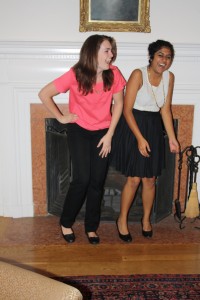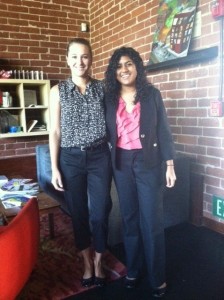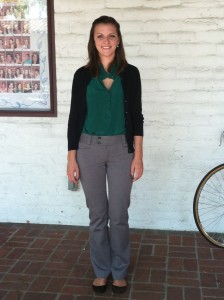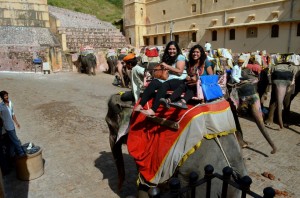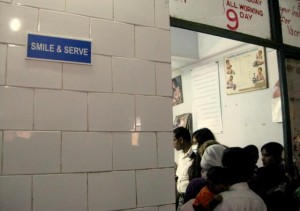This week’s blog post guest starts the one and only Bryn Morgan! We had a hilarious photoshoot in the Browning Living Room and interviewed each other on issues related to work attire and such. Keep your eyes peeled for a surprise visitor.
P: Describe your outfit choices and for what situations or occasions they would be worn.
B: All of the outfits you see in this post are ones I wear working as a Senior Interviewer interviewing prospective Scripps students for Admissions. The Scripps Admissions office is relatively relaxed and I would say most staff members wear business casual on a day-to-day basis.
This first outfit is basic and works well for my job in Admissions as well as interviews that don’t require more than business casual. I wore this outfit for a recent interview. While I love this pink top (it has a fun back!), a variety of other nice tops could be substituted to make a whole bunch of outfits. I’ll talk more about this later, but these black shoes and black trousers are comfortable and professional-looking staples that I wear all the time. For outfits like this one that are made up of blocks of color rather than patterns, I always like to have a necklace or some piece of jewelry like the gold one I’m wearing in this photo to keep things interesting.
Born Shoes, GAP trousers, shirt from Marshalls.
I have to confess that while I do wear this blouse and skirt often, I have yet to wear these heels in Admissions. I think heels are fun but my feet do not, so when given the chance I usually forgo anything platform for flats. I like this outfit because it’s a little more formal than the first while remaining colorful and fun (the quality of the picture isn’t high enough for you to make this out, but the pattern on my blouse is multicolor hearts). I don’t know what it is about pencil skirts, but I throw one on and automatically feel twice as professional!
Shirt and skirt from Forever 21, shoes from Urban Outfitters when I worked there and got a fantastic discount.
This last outfit is one I have been wearing a lot recently as the temperature seems determined to remain excruciatingly high. It’s flowy and comfortable but still put together. I have a number of more flowy knee-length skirts like this one and they have seemed so much more appealing than pencil skirts or trousers in this weather! Also featured here is my blue and green wooden painted fish necklace that I found at a yard sale and love wearing to Admissions. It reminds me to lighten up every time I see it and has been a great conversation starter. I wore it to a recent interview as Lesley in CP&R had told me during my mock with CP&R that sometimes it’s okay to see individuals’ personalities come out.
Born shoes, skirt from Forever 21, shirt was a hand-me-down.
P: I’m a student and don’t have a lot of money to spend on professional attire. How do I stay cost effective and cute?
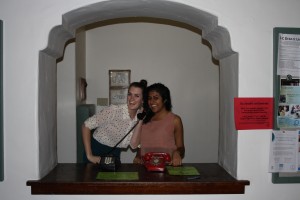 B: I talked a bit about how I was able to revamp my work appropriate wardrobe for working in Admissions on a budget in a blog post a few weeks ago and will elaborate here. Basically, I spent the most on two staples: my pair of black Born flats and black GAP trousers. I knew I would wear both items very frequently, and thought that having comfortable, supportive, and well made shoes that I could wear all the time and will (hopefully) last for quite awhile was worth it. From there, Marshalls and Forever 21 were my saving graces. Inexpensive, cute, and work appropriate clothes abound in both stores, at least this season, and I was able to get a good number of blouses, sleeveless tops, and pencil and flowy skirts for a very reasonable price. Find fun jewelry at yard sales and Goodwill to add some pizzaz to your outfits.
B: I talked a bit about how I was able to revamp my work appropriate wardrobe for working in Admissions on a budget in a blog post a few weeks ago and will elaborate here. Basically, I spent the most on two staples: my pair of black Born flats and black GAP trousers. I knew I would wear both items very frequently, and thought that having comfortable, supportive, and well made shoes that I could wear all the time and will (hopefully) last for quite awhile was worth it. From there, Marshalls and Forever 21 were my saving graces. Inexpensive, cute, and work appropriate clothes abound in both stores, at least this season, and I was able to get a good number of blouses, sleeveless tops, and pencil and flowy skirts for a very reasonable price. Find fun jewelry at yard sales and Goodwill to add some pizzaz to your outfits.
P: Halloween is around the corner—what the scariest clothing mishap you’ve ever had?
B: What comes to mind is just the other day in Admissions when I looked down after being there for about an hour and realized my blouse was on inside out. Luckily, the staff is extremely sweet and Meg, who fearlessly leads us from the front desk, and I laughed heartily together as I dashed into the bathroom to change. I’m sure now that you’ve asked me this question something truly scary will happen soon…I’ll report back.
P: Besides getting dressed, what’s the most intimidating part of an interview?
B: I really love interviews. I loved college interviews the first time around so much that I applied to interview prospective Scripps student four years later. What usually concerns me most is the possibility that I might not be able to get as much across to my interviewer(s) as I would like. For example, in a recent interview I had so much to say about a question they asked that I was disappointed I was only able to communicate a fraction of it in the short 25 minutes the interview lasted. But I just do my best to let my personality and passion for whatever it is I’m talking about come out, and try not to worry!
In an ideal world, what would your work attire be?
 Before I actually had to dress in professional attire 5 days a week in Beirut this summer, I thought I would hate feeling constrained to certain styles and items of clothing. It turns out I love dressing in professional attire and have especially been enjoying putting together outfits for Admissions this semester. In the future, having the flexibility of business causal would likely be preferable to wearing suits every day of the week, but I am delighted to find out that I don’t at all mind dressing up for work as it definitely leaves my options more open than if I were against being part of a workplace with a dress code.
Before I actually had to dress in professional attire 5 days a week in Beirut this summer, I thought I would hate feeling constrained to certain styles and items of clothing. It turns out I love dressing in professional attire and have especially been enjoying putting together outfits for Admissions this semester. In the future, having the flexibility of business causal would likely be preferable to wearing suits every day of the week, but I am delighted to find out that I don’t at all mind dressing up for work as it definitely leaves my options more open than if I were against being part of a workplace with a dress code.
Dear readers, we could do with some laughs and would love to hear your scary stories of clothing mishaps in interview or work settings!




